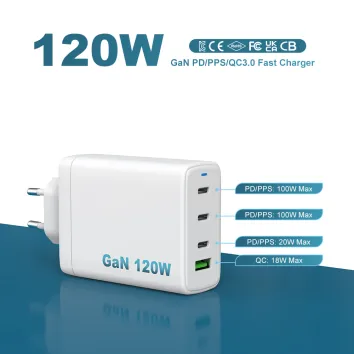Why Are Laptop Chargers Bigger Than Mobile Phone Chargers? Things You Didn't Know!
In today’s tech-driven world, we rely on our devices to stay connected, productive, and entertained. One thing that’s always on our minds, though, is charging these devices. If you’ve ever compared a laptop charger to a mobile phone charger, you may have wondered why your phone charger is so compact while your laptop charger is bulky. Let’s break this down in a simple yet insightful way by exploring the reasons behind this size difference and understanding modern charger technology.
Why I Wrote This Article
Whether it’s during travel or a busy workday, we’ve all had moments where we scramble for the right charger. Maybe you’ve tried using your phone charger for your laptop, or vice versa, only to find it either doesn’t work or takes forever. I wrote this article to clear up some common misconceptions about chargers and guide you in choosing the best charger for your needs—whether it’s for your phone, laptop, or both.
Why Are Laptop Chargers Bigger Than Phone Chargers?
Power Demand: The main reason laptop chargers are bigger comes down to one thing: power. Laptops simply need more juice than smartphones. Your average smartphone, like the iPhone, might use a 25W charger or 30W charger to charge quickly, while laptops, especially gaming or high-performance models, might need a 90W charger, 120W charger, or even 240W charger.
For example, think of your laptop as a car and your phone as a bicycle. The car will always need more fuel than the bicycle to run, just as your laptop requires more energy to stay powered. This explains why laptop chargers are larger, as they are designed to handle higher power requirements.
Heat Dissipation: Another reason for the size difference is heat. Higher wattage means more heat is generated. Laptop chargers are built with extra components like cooling systems to ensure that the charger doesn’t overheat while delivering large amounts of power. Meanwhile, phone chargers don’t have to handle nearly as much heat, which allows them to stay compact.
Understanding Charger Wattage: Which Charger Do You Need?
When it comes to chargers, size and wattage matter. Here’s a breakdown of charger wattage for various devices:
25W to 45W Chargers: Perfect for smartphones and tablets. A 30W charger or 35W charger is ideal for most smartphones, like the iPhone. If you want to speed things up even more, a 45W charger can charge some phones and tablets faster.

Read More
60W to 90W Chargers: Suitable for ultrabooks and lightweight laptops. A 60W charger could work for a MacBook Air, while a 90W charger might be needed for a MacBook Pro.

Read More
120W to 240W Chargers: These high-powered chargers are essential for powerful laptops like gaming rigs or laptops used for intensive tasks like video editing. For example, a gaming laptop may need a 150W charger or even a 240W charger to keep up with its energy demands during gameplay.

Read More
The Rise of GaN and PD Chargers: A Game Changer
With the rise of new technologies like GaN chargers and PD chargers, the size and efficiency of chargers have started to improve dramatically. GaN (Gallium Nitride) technology allows for smaller, more efficient chargers without sacrificing power output. Imagine a 65W GaN charger that’s as compact as a traditional 30W charger—perfect for those who want power without the bulk.
PD chargers (Power Delivery) are another advancement, especially when it comes to charging phones like the iPhone. If you’ve ever plugged in your phone and marveled at how fast it charges, it’s likely because you’re using a PD charger. For example, a 100W USB-C PD charger can charge both a laptop and a phone at their maximum speeds, making it a versatile option for people with multiple devices.
Wired or Wireless? The Eternal Debate
While wireless charging may seem more convenient, wired charging still reigns supreme when it comes to efficiency and speed. If you’ve ever placed your phone on a wireless pad and checked back 30 minutes later only to see a minimal increase in battery percentage, you know what I mean.
For example, if you use a 45W fast charger or even a 100W charger with a USB-C to Lightning cable, your iPhone will charge much faster than it would with a wireless pad. The takeaway? Wired chargers are still the best option for fast, efficient charging.
What Should You Consider When Buying a Charger?
Choosing the right charger can feel overwhelming with so many options. But don’t worry—here are a few key things to consider:
1. Device Compatibility: Make sure the charger’s wattage matches your device’s power requirements. Using a 25W charger for a laptop that needs 90W won’t cut it.
2. GaN Chargers: If you want something compact yet powerful, opt for a GaN charger. It can pack more wattage into a smaller size—ideal for travel or those with limited space.
2. Universal Travel Adapter: If you travel frequently, consider a universal travel adapter. This adapter can handle various plug types and voltages, saving you from the hassle of carrying multiple chargers.
4. PD Chargers: For fast, efficient charging, especially for devices like the iPhone, a PD charger paired with a type C charger or USB-C charger is an excellent choice.
In Summary: Choose Wisely, Charge Better
Whether you’re looking for a laptop charger, phone charger, or even a desktop charger, understanding the difference in power requirements and modern charger technologies will help you make an informed decision. GaN chargers, PD chargers, and fast chargers are changing the way we think about charging, offering smaller, more powerful solutions for our ever-growing power needs.
In the end, investing in the right charger means less frustration and more time enjoying your devices. So next time you’re charging your laptop or phone, you’ll know exactly why their chargers are built the way they are—and how to choose the best one for your needs.